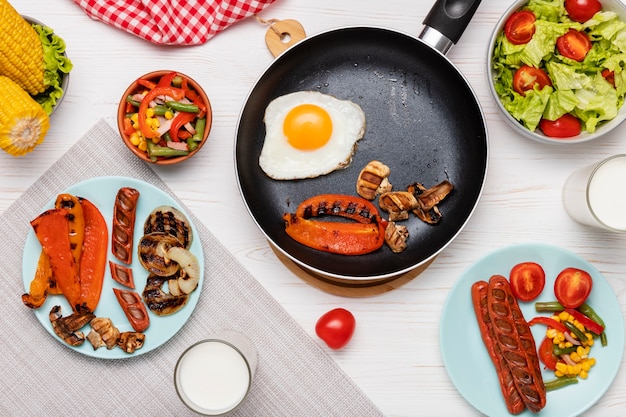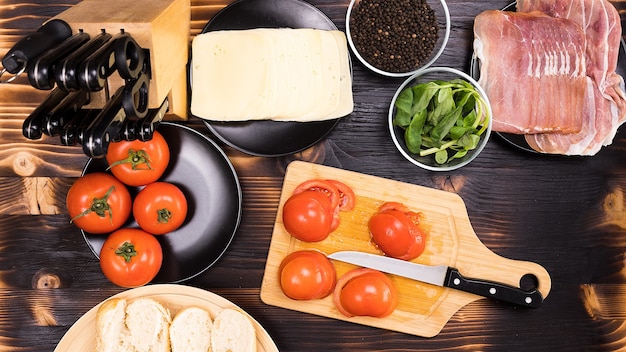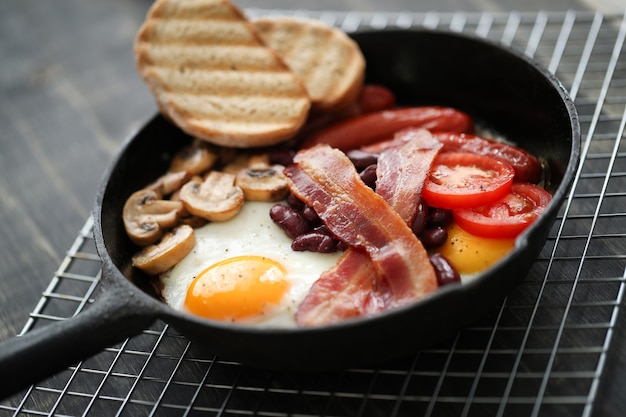There's something about the crisp snap of perfectly cooked bacon that elevates any breakfast, lunch, or even dinner. It's a symphony of textures and flavors: the satisfying crunch, the savory richness, the smoky aroma. For me, there's no better way to achieve that perfect crispy bacon than with a simple frying pan.
Now, I'm not talking about the kind of bacon that comes pre-cooked and limp, that you just nuke for a few seconds. I'm talking about the real deal, thick-cut, smoky, and juicy bacon, the kind that practically sings as it sizzles in the pan. And achieving that ideal level of crispiness, that magical balance between golden brown and shatteringly thin, is a journey I'm happy to share with you.
Over the years, I've experimented, I've burnt a few batches, and I've learned a thing or two about achieving that perfect crisp. This article is a culmination of those lessons, a guide to help you avoid the pitfalls and unlock the secrets of frying pan bacon perfection.
Part 1: choosing the right bacon

The Foundation of Flavor
Just like any great dish, your bacon journey starts with the right ingredients. You can't expect a culinary masterpiece if you're using subpar bacon. This is where many people stumble, mistaking convenience for quality.
I've tried those pre-cooked, paper-thin slices, and while they might be a quick fix, they lack the depth of flavor and the satisfying texture of good, old-fashioned thick-cut bacon.
Beyond the Packaging
The world of bacon offers a surprising variety. Here's a breakdown of the most popular types:
Thick-Cut Bacon: This is my personal favorite for frying. The thickness provides a juicy center and a gloriously crispy edge, creating a perfect balance of textures.
Regular-Cut Bacon: This cuts down on cooking time and delivers a more uniform crisp, but it might be a bit thin for some palates.
streaky bacon: This is the UK's answer to crispy bacon, known for its higher fat content and unique flavour.
Decoding the Fat Ratio
Ever looked at a package of bacon and wondered what that "fat ratio" means? Well, that number is your key to crispy bacon heaven. The higher the fat content, the more lusciously rendered it will be, leading to a more satisfyingly crispy result.
Aim for bacon with a fat content of at least 50%. It might sound like a lot, but trust me, you'll be rewarded with a melt-in-your-mouth experience.
Part 2: Prepping Your Bacon

Patience is a Virtue
I'll say it again: patience is key. Bacon is not a dish for the impatient. Rushing the process will lead to uneven cooking and a less than satisfying outcome.
The Moisture Myth
Now, here's where I differ from some culinary gurus. You'll often hear advice to pat your bacon dry. I say, let the bacon retain some of its natural moisture! It contributes to the overall richness and juiciness of the final product.
Instead of aggressively patting it dry, simply use paper towels to gently remove any excess moisture from the packaging.
Salt and Pepper: A Touch of Enhancement
I like to sprinkle a pinch of salt and pepper on my bacon before frying. This helps to draw out some moisture and enhance the natural flavors. Don't be afraid to adjust the seasoning to your liking.
Part 3: The Frying Pan Method: A Masterclass in Sizzling

The Cast Iron Advantage
A good frying pan is essential, and for bacon, cast iron reigns supreme. It heats evenly and retains heat beautifully, ensuring a consistent, even cook that's crucial for that perfect crisp.
Heat: The Golden Rule
Heat is your best friend and your worst enemy in this process. Too low, and the bacon will cook unevenly and release excess fat without achieving that satisfying crisp. Too high, and you risk burning the bacon before it has a chance to render.
The sweet spot? Medium heat, around 350 degrees fahrenheit. Your pan should be hot enough to sizzle when you add the bacon, but not so hot that it immediately starts smoking.
Laying the Foundation
Gently place the bacon slices in a single layer in the preheated pan. Don't overcrowd it! Give each slice some space to breathe, allowing for even cooking and preventing steaming, which can inhibit crispness.
The Art of Patience: Round Two
Now, resist the urge to flip that bacon! Let it cook undisturbed for 5-7 minutes, depending on the thickness. You'll know it's ready when the underside develops a beautiful golden brown hue.
Flipping the Script
Using a spatula, carefully flip the bacon. Keep the heat at medium, and let the other side cook until it reaches your desired level of crispiness.
Part 4: Achieving the Perfect Crisp: A Masterful Balancing Act
The Signs of Success
Your bacon's journey to crispness is a delicate dance between heat, time, and attention. Here's how to tell if it's reaching its peak:
Color: The bacon should be a deep, golden brown, almost mahogany in color. The edges will be beautifully caramelized.
Texture: The edges of the bacon should be firm and shatteringly thin, offering that irresistible crunch.
Sound: When you gently tap the bacon with a spatula, it should give off a crisp, almost drumming sound.
The Finishing Touch: Draining and Cooling
Once your bacon has achieved its peak crispiness, remove it from the pan and place it on a wire rack over a baking sheet to drain excess fat. This allows the bacon to cool slightly and prevents it from becoming soggy.
A Note on Paper Towels
Some cooks prefer to use paper towels to pat the bacon dry after cooking. This is a matter of personal preference. If you do use paper towels, be gentle to avoid tearing the bacon.
Part 5: Serving and Enjoying: A Symphony of Flavors
The Art of Pairing: Beyond the Breakfast Plate
There's no wrong way to enjoy crispy bacon. It's a culinary chameleon that fits seamlessly into countless dishes.
Classic Pairing: A hearty breakfast plate featuring fluffy scrambled eggs, toast, and crispy bacon is a timeless classic.
Beyond Breakfast: Bacon can add a touch of savory richness to salads, burgers, sandwiches, and even pasta dishes.
Sweet and Savory: Try drizzling your bacon with maple syrup or honey for a delightful sweet and savory combination.
Storage: Keeping the Crisp Alive
If you have leftover bacon, store it in an airtight container in the refrigerator for up to 5 days.
To reheat, simply place it on a baking sheet and bake in a preheated oven at 350 degrees Fahrenheit for a few minutes. This method helps to retain the crispiness.
Part 6: Variations and Experimentation: Beyond the Basic
Spiced Bacon: Adding a Layer of Depth
Why limit yourself to plain bacon when you can infuse it with exciting flavors? Experiment with spices like black pepper, cayenne pepper, paprika, and garlic powder. The possibilities are endless!
Sweet and Savory Bacon: A Taste Bud Tango
For a unique twist, try incorporating sweetness into your bacon. Drizzle it with maple syrup or honey before cooking. The sugars will caramelize, creating a delightful glaze.
bacon wrapped Delights: A Creative culinary adventure
Embrace your culinary creativity and wrap your bacon around chicken breasts, sausages, or even dates for a taste explosion.
Part 7: FAQs
1. Why is my bacon curling up?
Bacon curling is a common problem, often caused by uneven heat distribution. Try cooking over a lower heat or staggering the slices in the pan to allow for better air circulation.
2. My bacon is sticking to the pan!
This can happen if your cast iron pan is not properly seasoned. Ensure that your pan has a good, even seasoning. You can also try adding a bit of oil to the pan before cooking.
3. Do I need a thermometer for bacon?
There's no need for thermometers when cooking bacon. The visual cues and sound test are reliable indicators of doneness.
4. Can I cook bacon in the oven?
While oven-baked bacon is a perfectly acceptable method, I find that the frying pan delivers a more even crisp. It's more hands-on but offers greater control over the cooking process.
5. What happens if I overcook my bacon?
Overcooked bacon becomes dry, hard, and even burnt. It's crucial to remove it from the heat as soon as it reaches your desired level of crispiness.
Part 8: Conclusion
Frying pan bacon is an art form, a symphony of sizzling, crackling, and deliciousness. Mastering the art of achieving that perfect crisp requires patience, attention to detail, and a willingness to experiment.
Remember, the right bacon, the right heat, and the right amount of patience are the keys to unlocking the secrets of crispy bacon perfection. So, grab your frying pan, your favorite bacon, and embark on a culinary journey that will tantalize your taste buds. You won't regret it.
Everyone is watching

How to Cook Frozen Lobster Tails Perfectly: A Step-by-Step Guide
RecipesLobster. Just the word conjures up images of lavish meals, special occasions, and a taste of luxury. But let's...

Pigs in a Blanket Cooking Time: How Long to Bake for Perfect Results
RecipesAh, pigs in a blanket. Just the name conjures up images of those delightful little parcels of crispy pastry en...

Pork Fillet Cooking Time: How Long to Cook It Perfectly
RecipesPork fillet, or tenderloin as it's sometimes called, is a real favourite in our house. It's so versatile, and...

The Ultimate Guide to Tender, Juicy Pulled Pork
RecipesRight, let's talk pulled pork. It's one of those dishes that just screams "comfort food," doesn't it? I mean...

The Ultimate Guide to Cooking Sweet Potatoes: From Roasting to Mashing
RecipesSweet potatoes. Just the name conjures up images of warm, comforting dishes, bursts of vibrant color, and a to...
